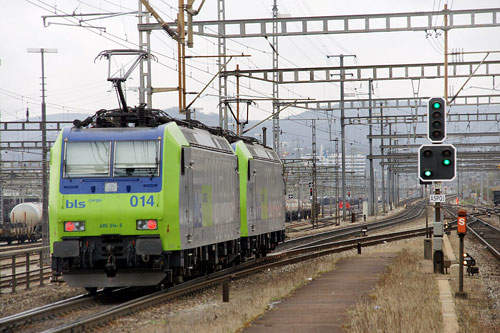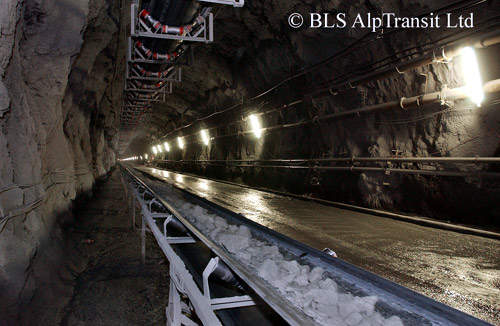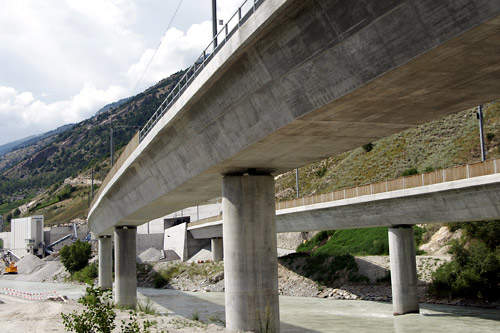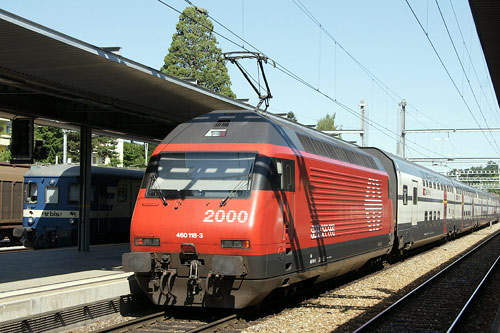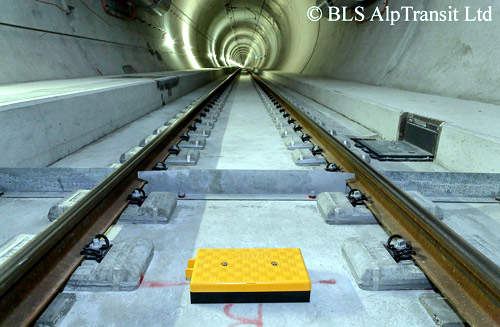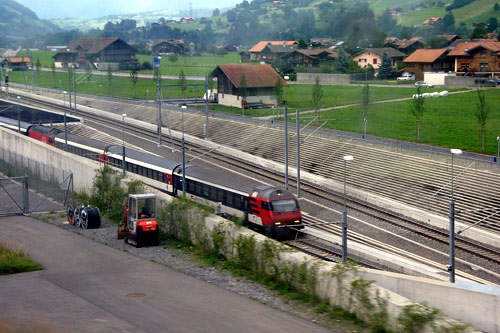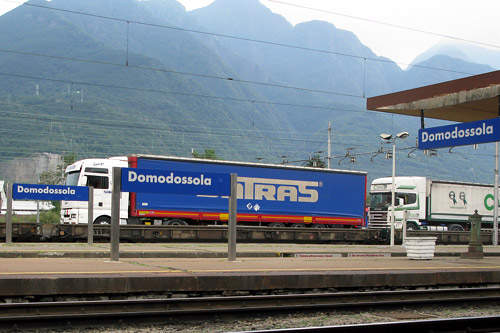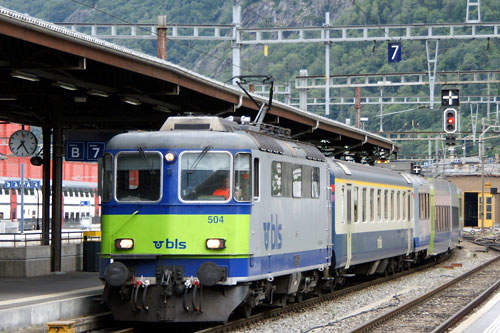On the second north-south mainline crossing of the Swiss Alps, the original 14.6km Lötschberg Tunnel opened in 1913. It created a route to Italy in combination with the first Simplon tunnel opened in 1906. Steep and (from the north) circuitous climbs to the Lötschberg summit left a legacy of slow transits, exacerbated by the rise in traffic, notably for freight on what has become the key Basel-Milan axis.
Like the longer Gotthard base tunnel which is unlikely to open before 2017, the new Lötschberg tunnel is part of Die Neuen Eisenbahn-Alpentransversalen (NEAT) / New Rail Link through the Alps (NRLA) project to shift transit traffic from road to rail.
In gaining EC acceptance for restrictions on road goods vehicles, Switzerland undertook to provide rail infrastructure for handling increasing tonnages and faster transits.
In providing a lower – around 400m lower than the old tunnel – and level route through the Alpine massif north of the Rhone Valley, Switzerland has also created a mixed-use high-speed railway.
The project
The new Lötschberg route was created under the control of specially formed BLS Alp Transit AG, a wholly owned subsidiary of BLS, second in size to SBB for 1,435mm operations. 'Private' BLS is largely in public ownership, the largest shareholders being Bern canton (55.8%) and the Swiss Confederation (21.7%).
Following test drillings from 1991, construction started in 1999, using a combination of drilling, blasting and for 20% of the distance, tunnel boring machines. To shorten the timescale, constructing the base tunnel was carried out from five sites. Also part of the project, the 2.6km Engstlige Tunnel was created by cut and cover.
For BLS local services and the accompanied car carriers between Goppenstein and Kandersteg, also to maintain capacity on the freight corridor, the high-level route is being retained. Due to tight pathing of trains through the incomplete tunnel, schedule slippages can lead to rerouting over the old line.
Infrastructure
As with the Channel Tunnel, the new Lötschberg route is built for clearance by shuttles of complete freight road vehicles. Within tunnels, slabbed track is used, with ballasted track on connecting lines. For servicing and part of the emergency arrangements, the tunnels are connected every 333m by cross passages. The tunnel has separate power supply systems for services and traction current.
The Lötschberg base tunnel is composed of twin single-track bores 40m apart between the north portal at Frutigen, where it diverges near the station from the original line, and the high-level south portal at Raron. The routing on to Brig is over parallel viaducts bringing the tracks down to the SBB Brig-Geneva line, thereby greatly increasing traffic on this section which largely runs alongside the metre-gauge Matterhorn Gotthard Bahn. Visp station has been completely rebuilt for its increased interchange role.
Due to concerns about overall NEAT project costs and the need to divert resources to the Gotthard line, the Lötschberg scheme was modified in advance of construction to operate with an incomplete infrastructure. Following official opening in June 2007, there were six months of testing plus freight transits prior to timetabled operations starting in December.
The western bore remains an unfitted carcass on the Ferden to Mitholz section, with the running tunnel to be constructed between Mitholz and Frutigen. In it present form, the Lötschberg Base Tunnel thereby requires single-line working over the majority of its length.
Rolling stock
With a realignment of responsibilities in 2004, SBB operates long-distance passenger services over the BLS-operated Lötschberg routes. Intercity trains of Class 460 locomotives and double-deck push-pull formations transferred to the base tunnel in late 2008.
Able to make use of the tunnel's eventual clearance for 250km/h operation, tilting Cisalpino high-speed trains provide the stock for Basel-Bern services to Italy, the FIAT/Alstom Ferroviaria multi-voltage ETR470 to be joined by the ETR610, undergoing testing during 2008. For the Bern-Brig section, the base tunnel project has almost halved timings of passenger services.
Principal freight operator is BLS Cargo, a BLS subsidiary which has encouraged external involvement to generate international traffic. By 2008 DB Schenker owned 45% of the shares and, due for delivery 2008–2009, BLS has ordered ten Bombardier multi-system TRAXX Class 486 for operation in Switzerland, Germany, Italy and Austria.
Signalling and communications
Requiring use by appropriately fitted stock and obviating lineside signalling, the tunnel is equipped throughout with ETCS Level 2. Control of the system, which extends as far south as Domodossola in Italy, is by the BLS centre at Spiez.
Much of the control equipment is in specially designed containers designed to withstand the 35°C and up to 80% humidity in the tunnel. In another timesaving measure, these were assembled and tested prior to tunnel installation.
The future
To encourage patronage of the more scenic original line via Kandersteg and to restructure its regional operations, from late 2008 BLS is replacing hauled stock with 13 purpose-built four-car Bombardier-Alstom RABe 535 "Lötschberger" EMU sets for Bern-Brig services.
The enforced cutback of the Lötschberg project means that the present operation has substantial potential for increased traffic subject to full completion, as yet not specified.
This will complete the western bore to give two single tracks throughout, plus fitting the in-tunnel Steg branch to the west-facing southern portal at Niedergesteln. Developing organisation BLS Alp Transit AG will go out of existence during 2008, with BLS Netz AG assuming responsibility.

